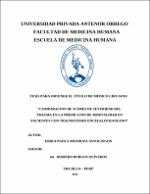Mostrar el registro sencillo del ítem
Comparación de scores de severidad del trauma en la predicción de mortalidad en pacientes con traumatismo encéfalo craneano
| dc.contributor.advisor | Burgos Oliveros, Homero | |
| dc.contributor.author | Mendoza Astolingon, Erika Paola | |
| dc.creator | Mendoza Astolingon, Erika Paola | |
| dc.date.accessioned | 2016-08-04T16:30:49Z | |
| dc.date.available | 2016-08-04T16:30:49Z | |
| dc.date.issued | 2014 | |
| dc.identifier.uri | https://hdl.handle.net/20.500.12759/1734 | |
| dc.description.abstract | Determinar el rendimiento diagnóstico del RTS (revised trauma score), NISS (new injury severity score), la Escala de Coma de Glasgow e índice de MADRAS en predecir mortalidad en pacientes con TEC en el Hospital Regional Docente de Trujillo. MATERIAL Y MÉTODO: Se realizó un estudio observacional, analítico, de pruebas diagnósticas, que evaluó 109 pacientes con traumatismo encéfalo craneano moderado a grave. RESULTADOS: La edad promedio de los pacientes que fallecieron y sobrevivieron fueron 30,61 ± 10,43 y 32,85 ± 7,83 años respectivamente; el 68,18% y 73,85% fueron varones en ambos grupos respectivamente. El tipo de trauma que predominó en ambos grupos fue el cerrado con 61,36% y 96,92% respectivamente; en relación a la sensibilidad, especificidad, VPP y VPN del score de la ECG, RTS, NISS y Madras, se obtuvo: 88,64%, 60%, 60% y 88,64% para el score de la ECG; 97,73%, 23,08%, 46,24% y 93,75% para el RTS; 97,73%, 89,23%, 86% y 98,31% para el NISS y 100%, 98,46%, 97,78% y 100% para la Escala de Madras. CONCLUSIONES: La escala de MADRAS resultó tener el mejor rendimiento pronóstico para mortalidad en pacientes con traumatismo encéfalo craneano. | es_PE |
| dc.description.abstract | To determine the diagnostic performance of the RTS (revised trauma score), NISS (new injury severity score), the Glasgow Coma Scale and MADRAS index to predict mortality in patients with TBI at Trujillo Regional Teaching Hospital. MATERIAL AND METHODS: We conducted a, analytical, observational study of diagnostic tests, which evaluated 109 patients with traumatic brain injury moderate to severe. RESULTS: The mean age of patients who died and survived were 30,61 ± 10,43 and 32,85 ± 7,83 years, respectively; the 68,18% and 73,85% were male in both groups respectively. The type of trauma that predominated in both groups was the blunt with 61,36% and 96,92% respectively; regarding the sensitivity, specificity, PPV and NPV of ECG score, RTS, NISS and Madras, was obtained: 88,64%, 60%, 60% and 88,64% for ECG score; 97,73%, 23,08%, 46,24% and 93,75% for the RTS; 97,73%, 89,23%, 86% and 98,31% for the NISS and 100%, 98,46%, 97,78% and 100% for the Scale of Madras. CONCLUSIONS: The MADRAS scale was found to have the best performance prognosis for mortality in patients with traumatic brain injury. | en_US |
| dc.description.uri | Tesis | es_PE |
| dc.format | application/pdf | es_PE |
| dc.language.iso | spa | es_PE |
| dc.publisher | Universidad Privada Antenor Orrego - UPAO | es_PE |
| dc.rights | info:eu-repo/semantics/openAccess | es_PE |
| dc.source | Universidad Privada Antenor Orrego | es_PE |
| dc.source | Repositorio institucional - UPAO | es_PE |
| dc.subject | Scores de trauma | es_PE |
| dc.subject | Traumatismo encéfalo craneano | es_PE |
| dc.title | Comparación de scores de severidad del trauma en la predicción de mortalidad en pacientes con traumatismo encéfalo craneano | es_PE |
| dc.type | info:eu-repo/semantics/bachelorThesis | es_PE |
| thesis.degree.level | Título Profesional | es_PE |
| thesis.degree.grantor | Universidad Privada Antenor Orrego. Facultad de Medicina Humana | es_PE |
| thesis.degree.name | Médico Cirujano | es_PE |
| thesis.degree.discipline | Medicina | es_PE |
Ficheros en el ítem
Este ítem aparece en la(s) siguiente(s) colección(es)
-
Medicina Humana [2739]

